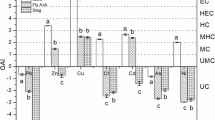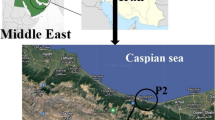Abstract
Municipal solid waste incineration (MSWI) for power generation can reuse waste effectively, but it generates a large amount of fly ash enriched with heavy metals. If this fly ash cannot be treated properly, it can cause ecological damage and human health risk. According to the production of ceramsites from MSWI fly ash, an evaluation methodology is established, in which the influence of heavy metal stability on the environment is considered for the first time, and the health risks of heavy metals via different exposure pathways are distinguished. The results show that heavy metals in MSWI fly ash have moderate potential environmental risks to environment and have strong non-carcinogenic and carcinogenic risks both to children and adults. By contrast, heavy metals in ceramsites pose little risk to environment and human health. This paper explains some reasons of heavy metal content and leaching ratio change in ceramsite and also illustrates why stability is a concern through comparing the potential risk index method and the improved evaluation method. This evaluation system can be applied to different production processes of building materials using solid hazardous waste and provides a quantitative evaluation method for reducing environment and human health risks of heavy metals.





Similar content being viewed by others
References
An, J., Gong, S., & Chen, W. (2016). Temporal and spatial characteristics and health risk assessments of heavy metal pollution in soils of Shenfu irrigation area. Journal of Agro-Environment Science, 35(1), 37–44.
Cheng, G., Li, Q., Su, Z., Sheng, S., & Fu, J. (2018). Preparation, optimization, and application of sustainable ceramsite substrate from coal fly ash/waterworks sludge/oyster shell for phosphorus immobilization in constructed wetlands. Journal of Cleaner Production, 175, 572–581.
Cheng, Y., Wong, Y., Whitwell, C., Innes, L., & Kaksonen, H. (2019). A new method for ranking potential hazards and risks from wastes. Journal of Hazardous Materials, 365, 778–788.
CSC (China State Council). (2016). Comprehensive work plan for energy conservation and emission reduction in the 13th Five-year Plan. Retrieved from, http://www.ndrc.gov.cn/zcfb/zcfbqt/201701/t20170105_834500.html. Accessed 12 Aug 2019.
Dong, B., Liu, X., Dai, L., & Dai, X. (2013). Changes of heavy metal speciation during high-solid anaerobic digestion of sewage sludge. Bioresource Technology, 131, 152–158.
Du, B., Li, J., Fang, W., Liu, Y., Yu, S., Li, Y., et al. (2018). Characterization of naturally aged cement-solidified MSWI fly ash. Waste Management, 80, 101–111.
Emenike, C., Tenebe, I., Omeje, M., & Osinubi, S. (2017). Health risk assessment of heavy metal variability in sachet water sold in Ado-Odo Ota, south-western Nigeria. Environmental Monitoring Assessment, 189(9), 480.
EPA. (1989). Risk assessment guidance for superfund. Human Health Evaluation Manual (part A). vol. I. EPA/540/1-89/002.
EPA. (1992a). Test method 1311-TCLP: Toxicity characteristic leaching procedure. United States Environmental Protection Agency.
EPA. (1992b). Guidelines for exposure assessment. Federal Register, 57(104), 22888–22938.
EPA. (1996). Proposed guidelines for carcinogen risk assessment. Federal Register, 61(79), 17960–18011.
EPA. (1997). Exposure factors handbook EPA/600/P-95/002F.
Fan, L., Zhang, Z., Yu, Y., Li, P., & Cosgrove, T. (2017). Effect of elevated curing temperature on ceramsite concrete performance. Construction and Building Materials, 153, 423–429.
GAQSIQ (General Administration of Quality Supervision Inspection and Quarantine), & SAC (Standardization Administration of China). (2010). Lightweight aggregates and its test methods—Part 1. Test methods for lightweight aggregate. GB/T 17431.1-2010. (in Chinese).
Gholizadeh, A., Taghavi, M., Moslem, A., Neshat, A., Najafi, L., Alahabadi, A., et al. (2019). Ecological and health risk assessment of exposure to atmospheric heavy metals. Ecotoxicology and Environmental Safety, 184, 109622.
Håkanson, L. (1984). Aquatic contamination and environmental risk. An attempt to a conceptual framework. Water Research, 18(9), 1107–1118.
Haris, H., Looi, J., Aris, Z., Mokhtar, F., Ayob, A., Yusoff, M., et al. (2017). Geo-accumulation index and contamination factors of heavy metals (Zn and Pb) in urban river sediment. Environmental Geochemistry and Health, 39(6), 1259–1271.
Huang, Y., Chen, Q., Deng, M., Japenga, J., Li, T., Yang, X., et al. (2018a). Heavy metal pollution and health risk assessment of agricultural soils in a typical peri-urban area in southeast China. Journal of Environmental Management, 207, 159–168.
Huang, Y., Deng, M., Wu, S., Japenga, J., Li, T., Yang, X., et al. (2018b). A modified receptor model for source apportionment of heavy metal pollution in soil. Journal of Hazardous Materials, 354, 161–169.
Kizinievič, O., Žurauskienė, R., Kizinievič, V., Yakovlev, G., & Bur’yanov, A. (2016). Use of sludge from drinking water purification in the production of effective ceramic articles. Glass and Ceramics, 73(1–2), 58–61.
Lederer, J., Trinkel, V., & Fellner, J. (2017). Wide-scale utilization of MSWI fly ashes in cement production and its impact on average heavy metal contents in cements: The case of Austria. Waste Management, 60, 247–258.
Li, R., Li, Y., Yang, T., Wang, L., & Wang, W. (2015). A new integrated evaluation method of heavy metals pollution control during melting and sintering of MSWI fly ash. Journal of Hazardous Materials, 289, 197–203.
Li, Z., Ma, Z., Kuijp, T., Yuan, Z., & Huang, L. (2014). A review of soil heavy metal pollution from mines in china: pollution and health risk assessment. Science of the Total Environment, 468–469, 843–853.
Li, R., Shu, T., Li, Y., Fang, F., & Yang, T. (2019). Migration characteristics and toxicity evaluation of heavy metals during the preparation of lightweight aggregate from sewage sludge. Environmental Science and Pollution Research, 26(9), 9123–9136.
Li, T., Wan, Y., Ben, Y., Fan, S., & Hu, J. (2017). Relative importance of different exposure routes of heavy metals for humans living near a municipal solid waste incinerator. Environmental Pollution, 226, 385–393.
Liu, M., Han, Z., & Yang, Y. (2019a). Accumulation, temporal variation, source apportionment and risk assessment of heavy metals in agricultural soils from the middle reaches of Fenhe River basin, North China. RSC Advances, 9(38), 21893–21902.
Liu, Z., Yue, Y., Lu, M., Zhang, J., Sun, F., Huang, X., et al. (2019b). Comprehension of heavy metal stability in municipal solid waste incineration fly ash with its compositional variety: A quick prediction case of leaching potential. Waste Management, 84, 329–339.
Long, G., Yang, J., & Xie, Y. (2017). The mechanical characteristics of steam-cured high strength concrete incorporating with lightweight aggregate. Construction and Building Materials, 136, 456–464.
Lu, W., Zhang, S., Hai, J., & Lei, M. (2017). Status and perspectives of municipal solid waste incineration in China: A comparison with developed regions. Waste Management, 69, 170–186.
MEP (Ministry of Environmental Protection of China). (2014). Technical guidelines for risk assessment of contaminated sites. HJ25. 3-2014. (in Chinese).
Mu, Y., Saffarzadeh, A., & Shimaoka, T. (2018). Utilization of waste natural fishbone for heavy metal stabilization in municipal solid waste incineration fly ash. Journal of Cleaner Production, 172, 3111–3118.
NBSC (National Bureau of Statistics of China). (2018). China statistical yearbook. Beijing: China Statistics Press.
Tang, Q., Zhang, Y., Gao, Y., & Gu, F. (2017). Use of cement-chelated, solidified, municipal solid waste incinerator (MSWI) fly ash for pavement material: mechanical and environmental evaluations. Canadian Geotechnical Journal, 54(11), 1553–1566.
Wang, H., Fan, X., Wang, N., Li, W., Sun, Y., Zhan, M., et al. (2018). Comparative leaching of six toxic metals from raw and chemically stabilized MSWI fly ash using citric acid. Journal of Environmental Management, 208, 15–23.
Wang, P., Hu, Y., & Cheng, H. (2019). Municipal solid waste (MSW) incineration fly ash as an important source of heavy metal pollution in China. Environmental Pollution, 252(2019), 461–475.
Weibel, G., Eggenberger, U., Kulik, A., Hummel, W., Schlumberger, S., Klink, W., et al. (2018). Extraction of heavy metals from MSWI fly ash using hydrochloric acid and sodium chloride solution. Waste Management, 76, 457–471.
Weibel, G., Eggenberger, U., Schlumberger, S., & Mäder, K. (2017). Chemical associations and mobilization of heavy metals in fly ash from municipal solid waste incineration. Waste Management, 62, 147–159.
Wu, W., Wu, P., Yang, F., Sun, L., Zhang, X., & Zhou, K. (2018a). Assessment of heavy metal pollution and human health risks in urban soils around an electronics manufacturing facility. Science of the Total Environment, 630, 53–61.
Wu, S., Zhou, S., Bao, H., Chen, D., Wang, C., Li, B., et al. (2019). Improving risk management by using the spatial interaction relationship of heavy metals and PAHs in urban soil. Journal of Hazardous Materials, 364, 108–116.
Wu, H., Zhu, Y., Bian, S., Ko, H., Li, Y., & Xu, Q. (2018b). H2S adsorption by municipal solid waste incineration (MSWI) fly ash with heavy metals immobilization. Chemosphere, 195, 40–47.
Xiao, Z., Yuan, X., Li, H., Jiang, L., Leng, L., Chen, X., et al. (2015a). Chemical speciation, mobility and phyto-accessibility of heavy metals in fly ash and slag from combustion of pelletized municipal sewage sludge. Science of the Total Environment, 536, 774–783.
Xiao, Q., Zong, Y., & Lu, S. (2015b). Assessment of heavy metal pollution and human health risk in urban soils of steel industrial city (Anshan), Liaoning, Northeast China. Ecotoxicology and Environmental Safety, 120, 377–385.
Xu, Z., Ni, S., Tuo, X., & Zhang, C. (2008). Calculation of heavy metals’ toxicity coefficient in the evaluation of potential environmental risk index. Environmental Science and Technology, 2(31), 112–115.
Xu, T., Wang, A., Zeng, Y., Zhao, X., Wang, L., Zhan, X., et al. (2019). Characterization of typical heavy metals in pyrolysis MSWI fly ash. Environmental Technology, 40(26), 3502–3511.
Xu, B., Xu, Q., Liang, C., Li, L., & Jiang, L. (2015). Occurrence and health risk assessment of trace heavy metals via groundwater in Shizhuyuan Polymetallic Mine in Chenzhou City, China. Frontiers of Environmental Science and Engineering, 9(3), 482–493.
Xuan, D., & Poon, S. (2018). Removal of metallic Al and Al/Zn alloys in MSWI bottom ash by alkaline treatment. Journal of Hazardous Materials, 344, 73–80.
Yang, S., Li, P., Liu, J., Bi, X., Ning, Y., Wang, S., et al. (2019). Profiles, source identification and health risks of potentially toxic metals in pyrotechnic-related road dust during Chinese New Year. Ecotoxicology and Environmental Safety, 184, 109604.
Yang, Z., Tian, S., Liu, L., Wang, X., & Zhang, Z. (2018). Application of washed MSWI fly ash in cement composites: long-term environmental impacts. Environmental Science and Pollution Research, 25(12), 12127–12138.
Yuan, Y., Xiang, M., Liu, C., & Theng, K. (2019). Chronic impact of an accidental wastewater spill from a smelter, China: A study of health risk of heavy metal(loid)s via vegetable intake. Ecotoxicology and Environmental Safety, 182, 109401.
Zhang, H., Zhao, Y., & Qi, J. (2011). Utilization of municipal solid waste incineration (MSWI) fly ash in ceramic brick: Product characterization and environmental toxicity. Waste Management, 31(2), 331–341.
Zhang, B., Zhou, W., Zhao, H., Tian, Z., Li, F., & Wu, Y. (2016). Stabilization/solidification of lead in MSWI fly ash with mercapto functionalized dendrimer Chelator. Waste Management, 50, 105–112.
Zhao, L., Xu, Y., Hou, H., Yu, S., & Li, F. (2014). Source identification and health risk assessment of metals in urban soils around the Tanggu chemical industrial district, Tianjin, China. Science of the Total Environment, 468, 654–662.
Zhu, M., & Guo, J. (2014). Sequential extraction of anaerobic digestate sludge for the determination of partitioning of heavy metals. Ecotoxicology and Environmental Safety, 102, 18–24.
Zong, Y., Xiao, Q., & Lu, S. (2017). Magnetic signature and source identification of heavy metal contamination in urban soils of steel industrial city, Northeast China. Journal of Soils and Sediments, 17(1), 190–203.
Acknowledgements
This work was supported by National Key R&D Program of China (2019YFC1908100), Natural Science Foundation of China (71974116) and Natural Science Foundation of Shandong Province (ZR2019MG009), Key R&D Project of Shandong Province (2018GSF122005, 2019RZE27013, 2019RKE27001) and Shandong Provincial Social Science Planning Research Project (20CGLJ13). The authors thank Professor Jon Kellett at The University of Adelaide for constructive suggestions and English improvement.
Author information
Authors and Affiliations
Corresponding author
Additional information
Publisher's Note
Springer Nature remains neutral with regard to jurisdictional claims in published maps and institutional affiliations.
Rights and permissions
About this article
Cite this article
Shi, Y., Li, Y., Yuan, X. et al. Environmental and human health risk evaluation of heavy metals in ceramsites from municipal solid waste incineration fly ash. Environ Geochem Health 42, 3779–3794 (2020). https://doi.org/10.1007/s10653-020-00639-7
Received:
Accepted:
Published:
Issue Date:
DOI: https://doi.org/10.1007/s10653-020-00639-7




